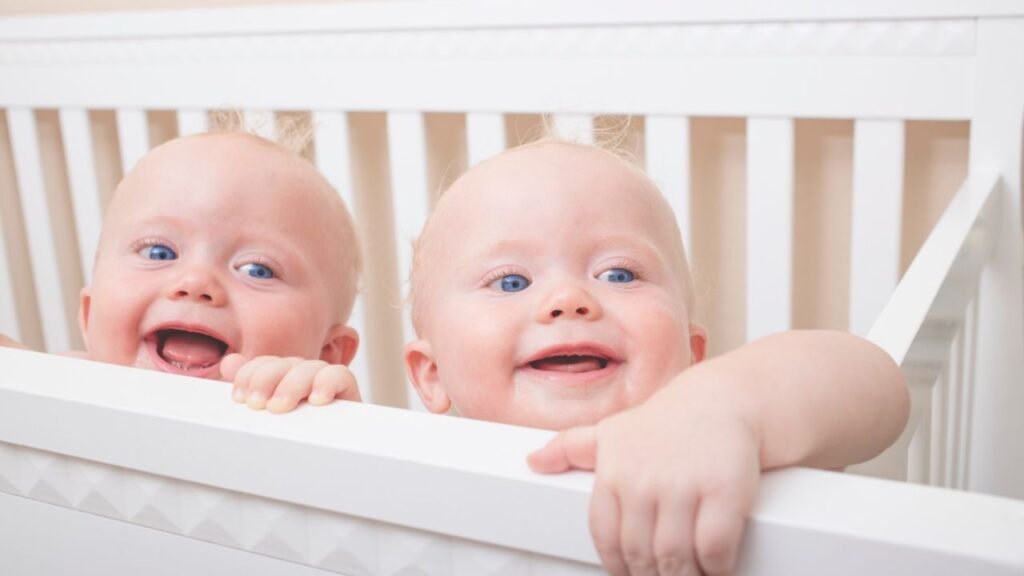You might wonder, can twins share a crib safely? Experts say that while many parents start out with both babies in one crib, you need to follow strict safety guidelines.
Most parents of twins co bed their babies in the early weeks. At four weeks, over 65% of twins share a crib, but this number drops to about 42% by thirteen weeks.
| Infant Age (weeks) | Percentage of Twins Cobedded (Crib Sharing) |
| 4 | >65% |
| 9 | >50% |
| 13 | ~42% |
You may worry about SIDS, comfort, and what works best for your family. With the right advice, you can make safe choices for your twins.
Can Twins Share a Crib?
Expert Advice
You might ask yourself, can twins share a crib safely? This question comes up for almost every parent of multiples. Experts do not always agree, so it helps to look at what leading organisations and paediatricians say.
Here’s a quick look at what the experts recommend:
| Aspect | Evidence from Paediatric Sleep Experts |
| Support for twins sharing a crib | The UK National Health Service says twins can share a crib during the first few weeks. Some hospital studies show twins may sleep better together, but this does not always apply at home. |
| Opposition to co bedding | The American Academy of Pediatrics (AAP) advises against twins sharing a crib. They say there is not enough research on safety and worry about a higher risk of sudden infant death syndrome (SIDS). |
| Risks identified | Higher risk of SIDS, especially for premature twins. Twins might bump or wake each other. Unsafe sleep positions, like side sleeping facing each other. |
| Benefits identified | Comfort from being close, like in the womb. Possible better sleep in hospital settings. Saving money by using one crib at first. |
| Expert recommendations | Move twins to separate cribs once they start to wiggle or roll. Always follow safe sleep rules: put babies on their backs, use a firm mattress, and avoid soft bedding. Ask your doctor for advice. |
| Parental discretion | You get to decide if your twins share a crib, but always use caution and follow safe sleep practices. |
You can see that the answer to can twins share a crib depends on who you ask. The NHS and some UK experts say it is fine for the first few weeks, as long as you follow strict safety rules.
The AAP in the United States takes a more cautious approach and recommends separate cribs from the start. Both sides agree that safety comes first and that you should move your twins to separate sleep spaces once they start moving around.
Tip: Always place your babies on their backs to sleep and keep the crib free of pillows, blankets, and toys.
Early Weeks vs. Later Months
The answer to can twins share a crib changes as your babies grow. In the early weeks, many parents find it easier to have both babies in one large cot.
You might notice your twins settle better when they are close, which can remind them of the womb. Some studies even suggest that twins may develop similar sleep patterns when they share a crib at first.
Here are some things to keep in mind during the newborn stage:
- You can place newborn twins in a large cot, feet to foot, on a firm mattress with no loose bedding.
- Always avoid small spaces like Moses baskets or bassinets for two babies.
- Never use rolled blankets or props to separate your twins in the crib.
As your twins grow, things change quickly. Once they start to roll, wiggle, or move around, it is time to move them into separate cribs.
This helps prevent one baby from rolling onto the other and reduces the risk of suffocation or SIDS. Separate cribs also give each baby more space and help you set up individual sleep routines.
You might worry about space or cost. Many parents use travel cots, rearrange furniture, or keep both cribs in the same room. You can also use baby monitors to keep an eye on both babies, even if they sleep apart.
Parents often face other challenges, too. Twins rarely sleep at the same time, so you might struggle to rest. Taking turns at night or asking for help from family can make things easier, but it is not always enough.
Many parents try white noise, dim lights, or letting babies sleep where they settle best, but these tricks do not always help you get more sleep.
Note: Keep checking your twins’ sleep needs as they grow. What works in the first month may not work later. Stay flexible and do what feels right for your family.
Risks and Benefits
SIDS and Safety Risks
When you think about twins sharing a crib, safety comes first. The biggest worry is the risk of Sudden Infant Death Syndrome (SIDS).
Paediatric sleep experts, including the American Academy of Pediatrics, strongly advise against co bedding twins. They say that sharing a crib can increase the risk of SIDS, especially if your babies are premature or very small.
Twins might accidentally roll onto each other or end up in unsafe sleep positions, like facing each other or lying on their sides. This can make it harder for them to breathe.
You might also notice that twins can wake each other up during the night. If one baby cries or moves, the other might not get enough rest.
Experts recommend that each twin sleeps on a separate, flat, and firm surface. This helps keep them safe and gives them space to move as they grow. Using a baby monitor can help you keep an eye on both babies at the same time, giving you peace of mind.
Tip: Always put your babies to sleep on their backs and keep the crib free from pillows, blankets, and toys.
Comfort and Bonding
Many parents feel that sharing a crib helps twins feel close and comforted. You might see your babies settle more quickly when they are together, as it reminds them of being in the womb.
Some studies in hospitals suggest that twins who sleep side by side may bond better and even sleep more soundly. Parents often choose crib sharing to make night time care easier and to support the special connection between their twins.
- Families often pick crib sharing to manage the extra work of caring for twins and to help them bond.
- Healthcare workers notice that twins seem calmer and sleep longer when together, which can make family life smoother.
- Some parents worry that separating twins too soon could be stressful for the babies, who are used to being close.
Still, experts say that safety should always come first. While crib sharing may offer comfort and bonding, the risks mean you should follow safe sleep guidelines and move your twins to separate cribs as soon as they start to roll or wiggle.
Guidelines for Safe Sleep
UK Recommendations
You may ask what the NHS and other UK groups say about twins sharing a cot. The NHS says you can let twins share a cot when they are small. You must follow safe sleep advice at all times.
Always put your babies on their backs, with their feet at the end of the cot. Their heads can face each other or be side by side. Never let them sleep on their sides. The Lullaby Trust and Twins Trust agree with this, as long as the cot has no soft bedding, pillows, or toys.
The NHS thinks co bedding can help twins feel safe and settle more easily. You must always use the same safe sleep rules as for one baby.
A table from new studies shows there is no big difference in weight gain, infection, or hospital stay between twins who share a cot and those who do not. Parents are just as happy either way.
| Outcome | Findings Summary |
| Weight gain | No big difference between co bedding and separate care |
| Apnoea, bradycardia, desaturation | No difference |
| Infection | No clear difference |
| Length of hospital stay | No clear difference |
| Parental satisfaction | No big difference |
International Advice
International rules, like those from the American Academy of Pediatrics (AAP), are much stricter. The AAP says twins should not share a crib.
They want each baby to have their own sleep space to lower the risk of sudden infant death syndrome (SIDS). You can keep both cots in the same room, but do not put both babies in one cot or crib.
The AAP also says to always put babies on their backs, use a firm mattress, and keep the sleep area free from soft things and loose bedding.
- Room sharing without bed sharing can cut SIDS risk by up to half.
- Twins should have their own sleep areas, even if they are in the same room.
- Never use adult beds, car seats, or swings for sleep.
So, can twins share a crib?
In the UK, you can let twins share a cot for a short time if you follow strict safety rules. International advice, especially from the US and Australia, says separate sleep spaces are safest. These differences come from different research and local rules, but all experts agree that safe sleep is most important.
Safe Co Bedding Tips
Positioning Twins
If you decide to let your twins share a crib, you need to think about how you place them. Start by always putting each baby on their back to sleep.
This is the safest position and helps lower the risk of SIDS. You can place your twins head to head at opposite ends of the cot, or side by side with their feet at the foot of the cot. Make sure there is enough space between them so they do not disturb each other.
Here’s a simple step by step guide for safe positioning:
- Lay both babies on their backs.
- Position them either head to head at opposite ends or side by side, feet at the foot of the cot.
- Keep the cot free from any loose items, like blankets or toys.
- Never use rolled towels or pillows to separate them.
- Watch for signs that your twins are starting to roll or move more.
Tip: Avoid placing the cot near windows, cords, or heavy curtains. These can be dangerous for curious babies.
Bedding and Sleepwear
You want your twins to be cosy, but safety comes first. Always use a firm, flat mattress with a fitted sheet. Do not add extra bedding, pillows, or stuffed animals.
These can increase the risk of suffocation. Dress your babies in soft, breathable sleepwear, such as a cotton sleepsuit or a baby sleeping bag. This keeps them warm without needing blankets.
Some parents ask, can twins share a crib if they use special bedding or dividers? Experts say you should avoid cot dividers and stick to the basics. If you want extra peace of mind, choose sleepwear that allows you to monitor your babies’ breathing, but remember, the safest option is always a clear, clutter free cot.
When to Separate
You might wonder when it’s time to move your twins into their own cots. The answer depends on how your babies grow and develop.
Once your twins start to roll, wiggle, or show signs of becoming more active, you should transition them to separate sleep spaces. This usually happens within the first few months. If one twin starts climbing or outgrows the cot, it’s also time to make the change.
| Sign to Separate | What to Look For |
| Rolling or crawling | Babies move around in the cot |
| Outgrowing the cot | Not enough space for both twins |
| Climbing attempts | Trying to get out of the cot |
| Disturbing each other | Waking or bumping each other |
Every baby is different, so watch for these signs and trust your instincts. Moving to separate cots helps keep both babies safe as they become more mobile.
You want your twins to sleep safely and comfortably. By following safe sleep guidelines and making decisions that fit your family, you lower the risks and help your babies rest well.
Experts say that sticking to these rules, like using a firm mattress and keeping the cot clear, really does make a difference. If you ever feel unsure, reach out to your health visitor or join a support group.
You are not alone—many parents face the same questions. Trust yourself and know you are doing your best for your twins.
FAQ
Can you use a Moses basket for twins?
No, you should not use a Moses basket for twins. These baskets are too small and do not give enough space for both babies to sleep safely. Stick to a large cot or crib.
Do twins wake each other up when sharing a crib?
Sometimes, yes. One twin might cry or move and disturb the other. Many parents find that twins get used to each other’s sounds and settle back to sleep quickly.
How long can twins share a crib?
You can let your twins share a crib until they start rolling or moving around. This usually happens within the first few months. After that, move them to separate cots for safety.
Is it safe to use cot dividers for twins?
Experts do not recommend cot dividers. These can be unsafe and increase the risk of suffocation. Always keep the cot clear and use a firm mattress with fitted sheets only.
What if one twin is sick—should you separate them?
If one twin is unwell, you might want to use separate cots. This can help stop germs from spreading and gives each baby their own space to recover.



